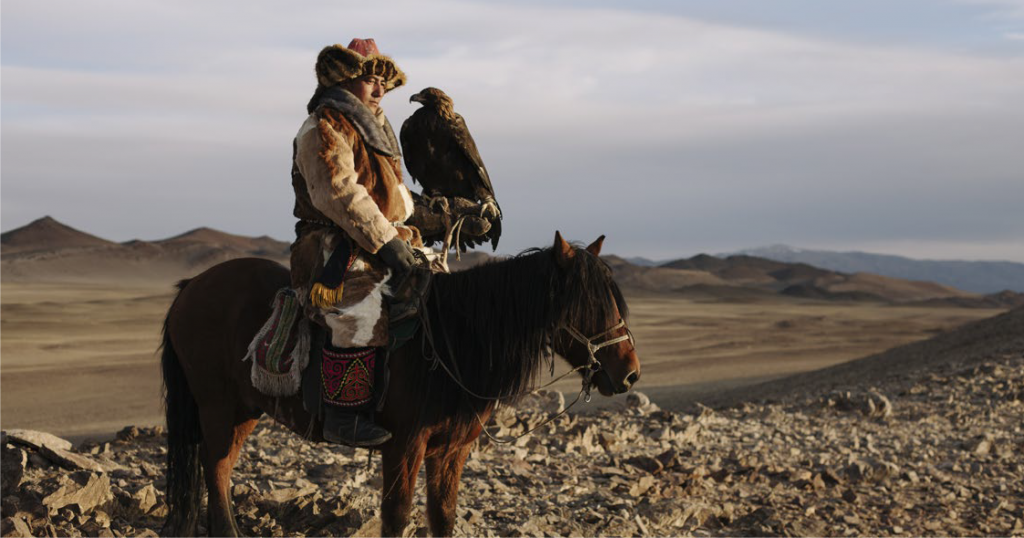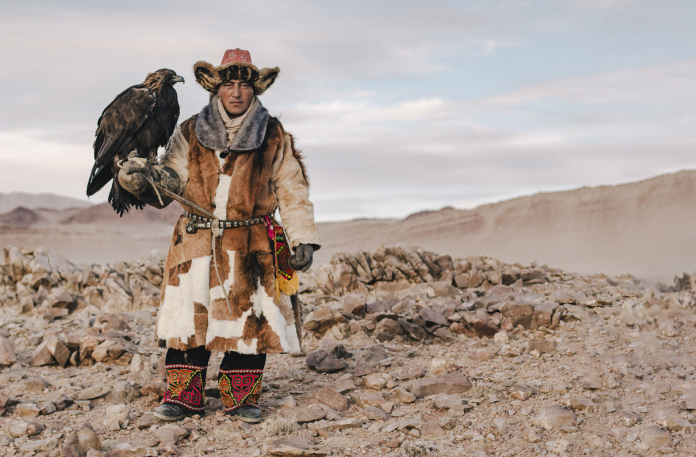Text and images by Bryan Chan and Marija Savic
Fitted in an enormous cowhide coat and a colourful peaked hat ringed with fur, the qusbegi in full regalia is a sight to behold. Khumarhan Khazubek sits atop a fine stallion broken from the wild, his left hand holds sturdy its reins, and his right arm is held at chest level, on which perches a full-grown golden eagle. Khazubek is one of 250 eagle hunters remaining in the region that still practises the ancient art of eagle hunting.
Qusbegi comes from the Kazakh words qus, for “lord”, and begi, which means “bird”. This link between eagle and hunter goes back centuries. It is a tradition that is passed down through family lineages and has been practised all across the steppes of Central Asia for more than 6,000 years. Marco Polo carefully documented the expeditions and exploits of Genghis Khan with his golden eagles. It is said that the Great Khan used to own thousands of such hunting birds.

Golden eagles get their name from the light brown feathers on their collar. Though they can be found all over the world, from Mexico, to the United States, Northern Africa to Europe, nowhere else are these wild birds so interwoven into a culture as with the Kazakhs of Mongolia. This tradition of hunting with golden eagles enables the qusbegis to retain a way of life far removed from the reaches of modernity, and survive brutal winters while living off- grid in their yurts.
The connection between hunter and eagle needs to be strong for such a cooperative to work, for golden eagles by nature are fiercely independent creatures. Their free-spirited quality means that it takes enormous amounts of time and care for a hunter to gain their trust. Although older eagles make better hunters with their killer instincts honed to take down large or fast prey such as wolves and foxes, it is the fledglings that the hunters prefer due to their easier trainability and safety – they won’t harm small children or their herd.

But the process of acquiring an eaglet is by no means a simple feat. Wild eagles nest high on the rocky ledges of the Altai mountains. To obtain an eaglet, hunters have to follow a mother back to her nest or scour the mountains to find one. Differentiating a female eagle from a male is the easy part. Females are distinctly larger with their wingspan reaching up to 2.5 metres and their weight reaching up to 7 kilograms, a third heavier than their male counterparts.
As eagle mothers usually foster only one of their babies, leaving the others to fend for themselves, the qusbegi waits for her to leave the nest before approaching the eaglets. Hunters have to be quick before the mother returns. Often, the precariously perched nests mean they have to fasten themselves to a rope and scale down rocky faces to reach the eaglets. As female birds are naturally more aggressive and capable of diving at speeds of up to 320 kilometres per hour to take down large prey such as goats and sheep, female fledgelings are the favoured choice of the qusbegis.
Once the eagle hunter chooses an eaglet, he becomes a surrogate parent to it for the next 10 years. During this time, he forms a deep relationship with his eagle as though it were his child. He spends many days and nights with his eagle, feeding the bird with his own hands, taking it into his yurt during the cold winter nights, all between training, disciplining, and nurturing it with affection.

“Golden eagles do not get trained easily. Without hardships, there won’t be a good eagle. You have to handle its character and its moods. If you are too strict with them, they will become too fierce and rebellious,” Tauekul, an eagle hunter of 30 years explains with his feathery companion by his side, it’s eyes covered with a black hood, the darkness keeping it calm and tranquil. “They can be vengeful creatures. You have to teach it without scaring it, and you have to give it its freedom, only then will it be quick to learn. If you neglect or harm them in any way, you will not be an eagle hunter.”
These days, only a handful of Kazakhs are true eagle hunters. Of the estimated 250 Kazakhs that still practise the fading art, a majority of them do it mainly for the well-paying tourist economy. They treat their eagles as pets instead of the wild fighting birds that they are. Times are surely changing, and the ancient tradition of the qusbegis faces a real threat from modernity and an increasingly disinterested youth.
Read the rest of this article in Asian Geographic No.141 Issue 2/2020 here or download a digital copy here!











